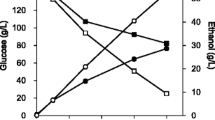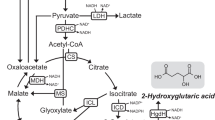Abstract
A Corynebacterium glutamicum strain with inactivated pyruvate dehydrogenase complex and a deletion of the gene encoding the pyruvate:quinone oxidoreductase produces about 19 mM l-valine, 28 mM l-alanine and about 55 mM pyruvate from 150 mM glucose. Based on this double mutant C. glutamicum △aceE △pqo, we engineered C. glutamicum for efficient production of pyruvate from glucose by additional deletion of the ldhA gene encoding NAD+-dependent l-lactate dehydrogenase (LdhA) and introduction of a attenuated variant of the acetohydroxyacid synthase (△C–T IlvN). The latter modification abolished overflow metabolism towards l-valine and shifted the product spectrum to pyruvate production. In shake flasks, the resulting strain C. glutamicum △aceE △pqo △ldhA △C–T ilvN produced about 190 mM pyruvate with a Y P/S of 1.36 mol per mol of glucose; however, it still secreted significant amounts of l-alanine. Additional deletion of genes encoding the transaminases AlaT and AvtA reduced l-alanine formation by about 50%. In fed-batch fermentations at high cell densities with adjusted oxygen supply during growth and production (0–5% dissolved oxygen), the newly constructed strain C. glutamicum △aceE △pqo △ldhA △C–T ilvN △alaT △avtA produced more than 500 mM pyruvate with a maximum yield of 0.97 mol per mole of glucose and a productivity of 0.92 mmol g −1(CDW) h−1 (i.e., 0.08 g g(CDW) −1 h−1) in the production phase.






Similar content being viewed by others
References
Blombach B, Schreiner ME, Moch M, Oldiges M, Eikmanns BJ (2007a) Effect of pyruvate dehydrogenase complex deficiency on l-lysine production with Corynebacterium glutamicum. Appl Microbiol Biotechnol 76:615–623
Blombach B, Schreiner ME, Holátko J, Bartek T, Oldiges M, Eikmanns BJ (2007b) l-Valine production with pyruvate dehydrogenase complex-deficient Corynebacterium glutamicum. Appl Environ Microbiol 73:2079–2084
Blombach B, Schreiner ME, Bartek T, Oldiges M, Eikmanns BJ (2008) Corynebacterium glutamicum tailored for high-yield l-valine production. Appl Microbiol Biotechnol 79:471–479
Blombach B, Stephan H, Brigitte B, Eikmanns BJ (2009) Acetohydroxyacid synthase, a novel target for improvement of l-lysine production by Corynebacterium glutamicum. Appl Environ Microbiol 75:419–427
Blombach B, Riester T, Wieschalka S, Ziert C, Youn JW, Wendisch VF, Eikmanns BJ (2011) Corynebacterium glutamicum tailored for efficient isobutanol production. Appl Environ Microbiol 77:3300–3310
Causey TB, Shanmugam KT, Yomano LP, Ingram LO (2004) Engineering Escherichia coli for efficient conversion of glucose to pyruvate. Proc Natl Acad Sci USA 101:2235–2240
Cicalese L, Hierholzer C, Subbotin V, Iyengar A, Rao AS, Stanko RT (1997) Protective effect of pyruvate during acute rejection of intestinal allografts: accompanied by up-regulation of inducible nitric oxide synthase mRNA. Transplant Proc 29:1813–1814
Cicalese L, Subbotin V, Rastellini C, Stanko RT, Rao AS, Fung JJ (1999) Preservation injury and acute rejection of rat intestinal grafts: protection afforded by pyruvate. J Gastrointest Surg 3:549–554
Cotellessa C, Manunta T, Ghersetich I, Brazzini B, Peris K (2004) The use of pyruvic acid in the treatment of acne. J Eur Acad Dermatol Venereol 18:275–278
DeBoer LW, Bekx PA, Han L, Steinke L (1993) Pyruvate enhances recovery of rat hearts after ischemia and reperfusion by preventing free radical generation. Am J Physiol 265:1571–1576
Dower WJ, Miller JF, Ragsdale CW (1988) High efficiency transformation of E. coli by high voltage electroporation. Nucleic Acids Res 16:6127–6145
Eggeling L, Bott M (2005) Handbook of Corynebacterium glutamicum. CRC Press, Boca Raton, USA, pp 13–16
Eikmanns BJ, Metzger M, Reinscheid D, Kircher M, Sahm H (1991) Amplification of three threonine biosynthesis genes in Corynebacterium glutamicum and its influence on carbon flux in different strains. Appl Microbiol Biotechnol 34:617–622
Eikmanns BJ, Thum-Schmitz N, Eggeling L, Lüdtke KU, Sahm H (1994) Nucleotide sequence, expression and transcriptional analysis of the Corynebacterium glutamicum gltA gene encoding citrate synthase. Microbiology 140:1817–1828
Ghersetich I, Brazzini B, Peris K, Cotellessa C, Manunta T, Lotti T (2004) Pyruvic acid peels for the treatment of photoaging. Dermatol Surg 30:32–36
Hanahan D (1983) Studies on transformation of Escherichia coli with plasmids. J Mol Biol 166:557–580
Howard JW, Fraser WA (1932) Preparation of pyruvic acid. Org Synth Coll 1:475–480
Inui M, Murakami S, Okino S, Kawaguchi H, Vertès AA, Yukawa H (2004a) Metabolic analysis of Corynebacterium glutamicum during lactate and succinate productions under oxygen deprivation conditions. J Mol Microbiol Biotechnol 7:182–196
Inui M, Kawaguchi H, Murakami S, Vertès AA, Yukawa H (2004b) Metabolic engineering of Corynebacterium glutamicum for fuel ethanol production under oxygen deprivation-conditions. J Mol Microbiol Biotechnol 8:243–254
Jolkver E, Emer D, Ballan S, Krämer R, Eikmanns BJ, Marin K (2009) Identification and characterization of a bacterial transport system for the uptake of pyruvate, propionate, and acetate in Corynebacterium glutamicum. J Bacteriol 191:940–948
Kato O, Youn JW, Stansen KC, Matsui D, Oikawa T, Wendisch VF (2010) Quinone-dependent d-lactate dehydrogenase Dld (Cg1027) is essential for growth of Corynebacterium glutamicum on d-lactate. BMC Microbiol 10:1471–2180
Krause FS, Blombach B, Eikmanns BJ (2010) Metabolic engineering of Corynebacterium glutamicum for 2-ketoisovalerate production. Appl Environ Microbiol 76:8053–8061
Lamprecht W, Heinz F (1983) Pyruvate. In: Bergmeyer HU (ed) Methods of enzymatic analysis, vol VI, 3rd edn. Verlag Chemie Weinheim, Germany, pp 570–577
Leuchtenberger W, Huthmacher K, Drauz K (2005) Biotechnological production of amino acids and derivatives: current status and prospects. Appl Microbiol Biotechnol 69:1–8
Li Y, Chen J, Lun SY (2001) Biotechnological production of pyruvic acid. Appl Microbiol Biotechnol 57:451–459
Liebl W (2006) The genus Corynebacterium—nonmedical. In: Dworkin M, Falkow S, Rosenberg E, Schleifer KH, Stackebrandt E (eds) The prokaryotes, vol 3, 3rd edn. Springer, New York, pp 796–818
Litsanov B, Kabus A, Brocker M, Bott M (2011) Efficient aerobic succinate production from glucose in minimal medium with Corynebacterium glutamicum. Microb Biotechnol, Epub ahead of print. doi:10.1111/j.1751-7915.2011.00310.x
Marienhagen J, Eggeling L (2008) Metabolic function of Corynebacterium glutamicum aminotransferases AlaT and AvtA and impact on l-valine production. Appl Environ Microbiol 74:7457–7462
Marienhagen J, Kennerknecht N, Sahm H, Eggeling L (2005) Functional analysis of all aminotransferase proteins inferred from the genome sequence of Corynebacterium glutamicum. J Bacteriol 187:7639–46
Martínez I, Bennett GN, San KY (2010) Metabolic impact of the level of aeration during cell growth on anaerobic succinate production by an engineered Escherichia coli strain. Metab Eng 12:499–509
Mimitsuka T, Sawai H, Hatsu M, Yamada K (2007) Metabolic engineering of Corynebacterium glutamicum for cadaverin fermentation. Biosci Biotechnol Biochem 71:2130–2135
Nishimura T, Vertès AA, Shinoda Y, Inui M, Yukawa H (2007) Anaerobic growth of Corynebacterium glutamicum using nitrate as a terminal electron acceptor. Appl Microbiol Biotechnol 75:889–897
Okino S, Noburyu R, Suda M, Jojima T, Inui M, Yukawa H (2008a) An efficient succinic acid production process in a metabolically engineered Corynebacterium glutamicum strain. Appl Microbiol Biotechnol 81:459–464
Okino S, Suda M, Fujikura K, Inui M, Yukawa H (2008b) Production of d-lactic acid by Corynebacterium glutamicum under oxygen deprivation. Appl Microbiol Biotechnol 78:449–454
Peters-Wendisch PG, Wendisch VF, Paul S, Eikmanns BJ, Sahm H (1997) Pyruvate carboxylase as an anaplerotic enzyme in Corynebacterium glutamicum. Microbiology 143:1095–1103
Peters-Wendisch PG, Kreutzer C, Kalinowski J, Pátek M, Sahm H, Eikmanns BJ (1998) Pyruvate carboxylase from Corynebacterium glutamicum: characterization, expression and inactivation of the pyc gene. Microbiology 144:915–927
Roufs JB (1996) Pyruvate: does it amp endurance and burn more fat? Muscle Fitness 57:195–197
Sasaki M, Jojima T, Inui M, Yukawa H (2010) Xylitol production by recombinant Corynebacterium glutamicum under oxygen deprivation. Appl Microbiol Biotechnol 86:1057–1066
Sauer U, Eikmanns BJ (2005) The PEP–pyruvate–oxaloacetate node as the switch point for carbon flux distribution in bacteria. FEMS Microbiol Rev 29:765–794
Schäfer A, Tauch A, Jäger W, Kalinowski J, Thierbach G, Pühler A (1994) Small mobilizable multi-purpose cloning vectors derived from the E. coli plasmids pK18 and pK19: selection of defined deletions in the chromosome of Corynebacterium glutamicum. Gene 145:69–73
Schneider J, Wendisch VF (2010) Putrescine production by engineered Corynebacterium glutamicum. Appl Microbiol Biotechnol 88:859–868
Schneider J, Wendisch VF (2011) Biotechnological production of polyamines by bacteria: recent achievements and future perspectives. Appl Microbiol Biotechnol 91:17–30
Schreiner ME, Fiur D, Holátko J, Pátek M, Eikmanns BJ (2005) E1 enzyme of the pyruvate dehydrogenase complex in Corynebacterium glutamicum: molecular analysis of the gene and phylogenetic aspects. J Bacteriol 187:6005–6018
Schreiner ME, Riedel C, Holátko J, Patek M, Eikmanns BJ (2006) Pyruvate:quinone oxidoreductase in Corynebacterium glutamicum: molecular analysis of the pqo gene, significance of the enzyme, and phylogenetic aspects. J Bacteriol 188:1341–1350
Sekine H, Shimada T, Hayashi C, Ishiguro A, Tomita F, Yokota A (2001) H + −ATPase defect in Corynebacterium glutamicum abolishes glutamic acid production with enhancement of glucose consumption rate. Appl Microbiol Biotechnol 57:534–540
Smith KM, Cho KM, Liao JC (2010) Engineering Corynebacterium glutamicum for isobutanol production. Appl Microbiol Biotechnol 87:1045–1055
Stanko RT, Robertson RJ, Galbreath RW, Reilly JJ, Greenawalt KD, Goss FL (1990) Enhanced leg exercise endurance with a high-carbohydrate diet and dihydroxyacetone and pyruvate. J Appl Physiol 69:1651–1656
Stanko RT, Tietze DL, Arch JE (1992a) Body composition, energy utilization, and nitrogen metabolism with a severely restricted diet supplemented with dihydroxyacetone and pyruvate. Am J Clin Nutr 55:771–776
Stanko RT, Tietze DL, Arch JE (1992b) Body composition, energy utilization, and nitrogen metabolism with a 4.25-MJ/d low-energy diet supplemented with pyruvate. Am J Clin Nutr 56:630–635
Stansen C, Uy D, Delaunay S, Eggeling L, Goergen JL, Wendisch VF (2005) Characterization of a Corynebacterium glutamicum lactate utilization operon induced during temperature-triggered glutamate production. Appl Environ Microbiol 71:5920–5928
Takors R, Bathe B, Rieping M, Hans S, Kelle R, Huthmacher K (2007) Systems biology for industrial strains and fermentation processes—example: amino acids. J Biotechnol 129:181–190
van der Rest ME, Lange C, Molenaar D (1999) A heat shock following electroporation induces highly efficient transformation of Corynebacterium glutamicum with xenogenic plasmid DNA. Appl Microbiol Biotechnol 52:541–545
Veit A, Rittmann D, Georgi T, Youn JW, Eikmanns BJ, Wendisch VF (2009) Pathway identification combining metabolic flux and functional genomics analyses: acetate and propionate activation by Corynebacterium glutamicum. J Biotechnol 140:75–83
Wendisch VF, Bott M, Eikmanns BJ (2006) Metabolic engineering of Escherichia coli and Corynebacterium glutamicum for biotechnological production of organic acids and amino acids. Curr Opin Microbiol 9:268–274
Yokota A, Shimizu H, Terasawa Y, Takaoka N, Tomita F (1994a) Pyruvic acid production by a lipoic acid auxotroph of Escherichia coli W1485. Appl Microbiol Biotechnol 41:638–646
Yokota A, Terasawa Y, Takaoka N, Shimizu H, Tomita F (1994b) Pyruvic acid production by an F1-ATPase-defective mutant of Escherichia coli W1485lip2. Biosci Biotechnol Biochem 58:2164–2167
Zelić B, Gerharz T, Bott M, Vasić-Rački Đ, Wandrey C, Takors R (2003) Fed-batch process for pyruvate production by recombinant Escherichia coli YYC202 strain. Eng in Life Sci 3:299–305
Zhu Y, Eiteman MA, Altman R, Altman E (2008) High glycolytic flux improves pyruvate production by a metabolically engineered Escherichia coli strain. Appl Environ Microbiol 74:6649–6655
Zimmermann HF, Anderlei T, Büchs J, Binder M (2006) Oxygen limitation is a pitfall during screening for industrial strains. Appl Microbiol Biotechnol 72:1157–1160
Acknowledgements
We thank L. Eggeling and J. Marienhagen (both IBG-1, Research Center Jülich) for providing plasmids pK19mobsacB ΔalaT and pK19mobsacB ΔavtA, V.Wendisch (Faculty of Biology and CeBiTec, University of Bielefeld) for providing plasmid pK19mobsacB ΔldhA, and M. Oldiges (IBG-1, Research Center Jülich) for technical advice. The support of the Fachagentur Nachwachsende Rohstoffe (FNR) of the Bundesministerium für Ernährung, Landwirtschaft und Verbraucherschutz (FNR grant 220-095-08A; BioProChemBB project, ERA-IB program) is gratefully acknowledged.
Author information
Authors and Affiliations
Corresponding author
Rights and permissions
About this article
Cite this article
Wieschalka, S., Blombach, B. & Eikmanns, B.J. Engineering Corynebacterium glutamicum for the production of pyruvate. Appl Microbiol Biotechnol 94, 449–459 (2012). https://doi.org/10.1007/s00253-011-3843-9
Received:
Revised:
Accepted:
Published:
Issue Date:
DOI: https://doi.org/10.1007/s00253-011-3843-9




